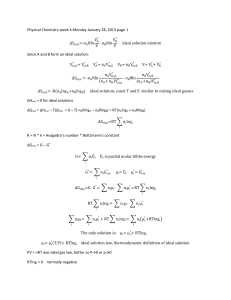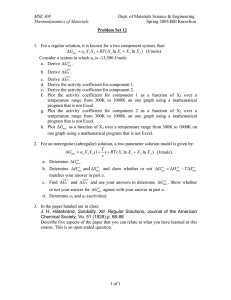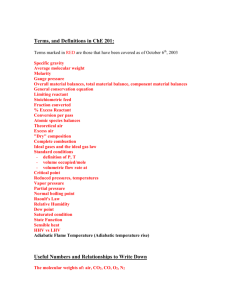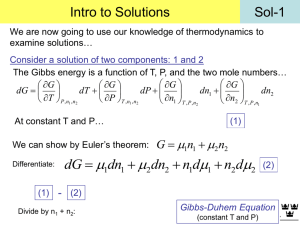5.60 Thermodynamics & Kinetics
advertisement
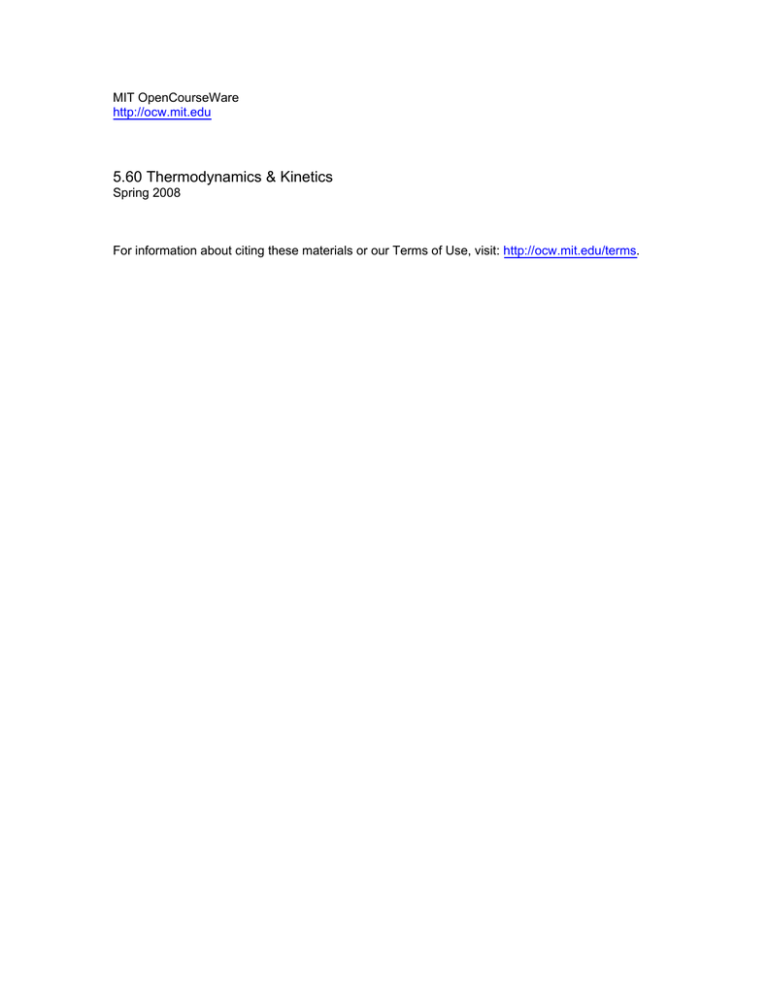
MIT OpenCourseWare http://ocw.mit.edu 5.60 Thermodynamics & Kinetics Spring 2008 For information about citing these materials or our Terms of Use, visit: http://ocw.mit.edu/terms. 5.60 Spring 2008 Lecture #22 Two-Component Phase Equilibria III Ideal and Non-Ideal Solutions Free energy change ∆Gmix in ideal solutions ∆G A (liq) B (liq) G1 (l) = nAxAµA* (l) + nBxBµB* (l) A + B (liq) G2 (l) = nAxAµAmix (l) + nBxBµBmix (l ) ∆Gmix = G2 (l) − G1 (l) = nxA ⎡⎣µA∗ (l) + RTln xA ⎤⎦ + nxB ⎡⎣µB∗ (l) + RTln xB ⎤⎦ − nxAµA∗ (l) − nxBµB∗ (l) ∆Gmix = nRT ( xA ln xA + xB ln xB ) Purely entropic, as in gas mixture G = Vdp – SdT ⎛ ∂∆Gmix ⎞ ∆Smix = − ⎜⎜ ⎟⎟ = −nR ( xA ln xA + xB ln xB ) ∂T ⎝ ⎠p ∆Hmix = ∆Gmix + T∆Smix = 0 No enthalpy change, all of ∆G is due to entropy of mixing Change in volume ∆Vmix ⎛ ∂∆Gmix ⎞ ⎟⎟ = 0 ⎝ ∂p ⎠T ∆Vmix = ⎜⎜ No volume change, just like ideal gas. page 1 5.60 Spring 2008 Lecture #22 page 2 Non-Ideal Solutions: In reality, molecules interact: A B A A A B B B uAA < 0 PURE uBB < 0 uAB MIXED uAB ∆u = 2uAB- (uAA + uBB) This difference determines how solutions depart from ideality. I. Positive Deviations: ∆u > 0 (most common) Mixing is energetically not favorable in liquid phase. ∆H = ∆U + ∆(PV) ≈ ∆U ∆Gmix = n ∆u + nRT ( xA ln xA + xB ln xB ) > ∆Gmix (ideal) 4 e.g. acetone & carbon disulphide CH3 CH3 C=O A + S=C=S B 5.60 Spring 2008 Lecture #22 page 3 p = pA + pB p Real * pCS = pB* 2 * pacetone = pA* Raoult pB xCS2 = xB 0 1 pA * pCS > xCS pCS 2 2 2 * pacetone > xacetonepacetone ⇒ ptot (real) > ptot (Raoult ) ⇒ vapor pressure is higher than expected by Raoult’s Law II. Negative Deviations: ∆u < 0 e.g. acetone & chloroform CH3 CH3 Cl C=O + H - C - Cl Cl A B H-bonding attraction Mixing is energetically favorable in liquid phase. 5.60 Spring 2008 Lecture #22 page 4 p = pA + pB p Real * pCHCl = pB* 3 * pacetone = pA * Raoult pB xCHCl3 = xB 0 pA 1 * pCS < xCS pCS 2 2 2 * pCHCl < xCHCl pCHCl 3 3 3 ⇒ ptot (real) < ptot (Raoult ) Ideal Dilute Solutions and Henry’s Law: Non-ideal solutions are difficult to describe completely ⇒ Describe limits xB → 1 and xB → 0 ⇒ “Ideal Dilute Solution” I. xCS2 = xB → 1 (B is the “solvent”) Then Raoult’s Law applies for CS2 CS2 molecules see mostly other CS2 molecules * pCS = xCS pCS 2 2 2 5.60 Spring 2008 Lecture #22 page 5 II. xB → 0 (B is the “solute”) Then Henry’s Law applies: pCS = xCS KCS 2 2 2 pB = xBKB Henry’s Law constant KB ≡ Henry’s Law constant, depends on the solvent/solute mixture and the temperature. Labeled just KB, even though it depends on A also. KCS2 = KB Real p Positive deviation ⇒ KB > pB* Henry * * pCS = p B 2 (Negative deviation would have KB < pB* ) Raoult 0 xCS2 = xB Ideal dilute solution: Solvent, e.g. A: Solute, e.g. B: xA ~ 1 xB ~ 0 ⇒ ⇒ Raoult’s Law Henry’s Law pA = xA pA* p B = x B KB 1 5.60 Spring 2008 Lecture #22 page 6 Total phase diagram: Ideal p Real p Liquid phase pA* pB* pA* gas phase xB,yB 0 Liquid phase pB* 1 gas phase xB,yB 0 1 Stronger non-ideality: Azeotropes Liquid phase p pB* * pA At this point xB = yB gas phase xB,yB 0 1 Cannot distill past azeotrope xB = yB Similar for constant p phase diagram Can have positive or negative azeotropes T T gas phase TA* TA* TB* Liquid phase 0 gas phase xB,yB 1 TB* Liquid phase 0 xB,yB 1
